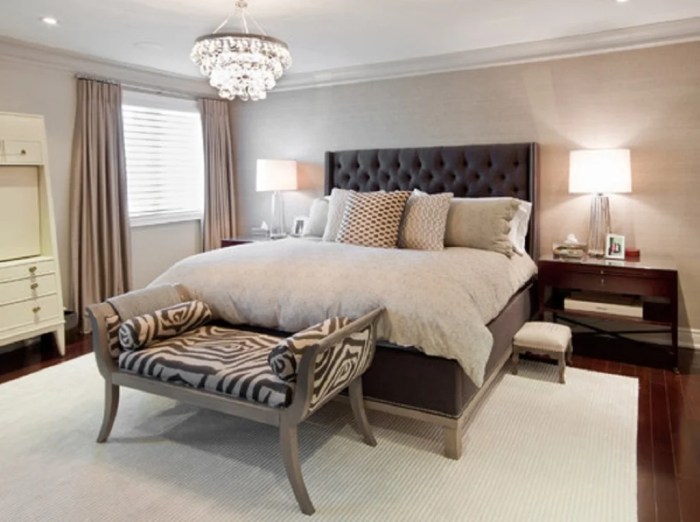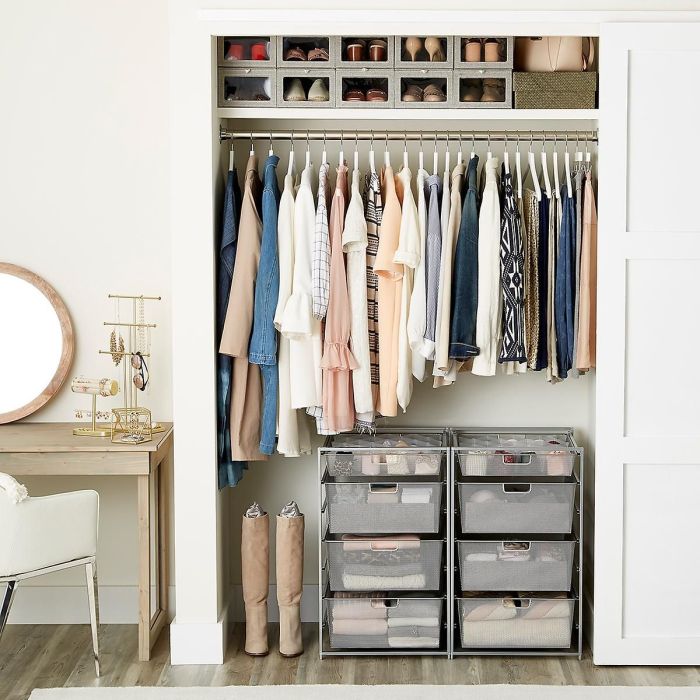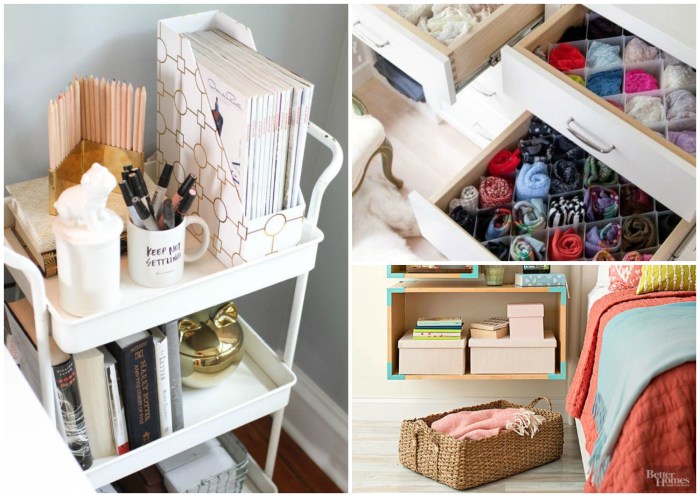Trying To Decorate My Bedroom While Organizing might seem like a daunting task, a chaotic blend of purging possessions and crafting a stylish sanctuary. But with a strategic approach, this project can transform from overwhelming to incredibly rewarding. This guide breaks down the process into manageable steps, from decluttering and organizing your space to selecting a design style and sourcing affordable décor.
We’ll cover everything from maximizing storage in small bedrooms to creating a budget-friendly plan and implementing your vision, leaving you with a bedroom that’s both beautiful and functional.
We’ll explore various design styles, helping you choose a color palette and furniture that complements your personal aesthetic and the room’s dimensions. Learn how to create mood boards to visualize your dream bedroom, and discover practical tips for arranging furniture, hanging artwork, and incorporating personal touches. We’ll even delve into DIY projects to add unique character and save money.
By the end, you’ll have the confidence and tools to create the bedroom of your dreams.
Style and Design Planning: Trying To Decorate My Bedroom While Organizing

Transforming your bedroom from a cluttered space into a haven of relaxation and style requires careful planning. Understanding different design aesthetics and selecting a cohesive color palette are crucial steps in achieving your desired atmosphere. This section will guide you through the process, offering practical advice and visual inspiration.
Bedroom Design Styles and Their Characteristics
Different design styles cater to diverse personalities and preferences. A minimalist bedroom prioritizes functionality and clean lines, often featuring a neutral color palette and a limited number of carefully selected furniture pieces. Bohemian styles, conversely, embrace eclecticism, layering textures, patterns, and colors to create a vibrant and free-spirited atmosphere. Modern bedrooms emphasize sleekness and simplicity, utilizing contemporary furniture and a sophisticated color scheme.
Each style offers a unique approach to creating a personalized space.
Color Palette Selection for Bedrooms
Choosing the right color palette significantly impacts the mood and feel of your bedroom. Consider the size and lighting of the room. Light, airy colors like pastels or whites can make a small room feel larger and brighter. Darker colors, while creating a cozy and intimate ambiance, can make a small room feel smaller. Natural light plays a crucial role; rooms with abundant natural light can handle bolder color choices than those with limited light.
Align your color palette with your chosen design style; for example, a minimalist bedroom might utilize a monochromatic scheme, while a bohemian room could incorporate a rainbow of earthy tones.
Mood Board Examples: Three Distinct Bedroom Styles
Creating mood boards is an effective way to visualize your design ideas. Here are three examples:
Mood Board 1: Minimalist Bedroom
This mood board features images of a simple white platform bed, a sleek nightstand with a minimalist lamp, a neutral-toned rug, and a single piece of abstract art on the wall. The overall palette is predominantly white and gray, with subtle accents of natural wood. The feeling is clean, uncluttered, and serene.
Mood Board 2: Bohemian Bedroom
This mood board showcases a mix of textures and patterns. Images include a low-lying bed with a colorful patterned quilt, woven wall hangings, a variety of throw pillows in rich earth tones and vibrant jewel tones, a macrame plant hanger, and a vintage rug. The overall effect is layered, eclectic, and warm.
Mood Board 3: Modern Bedroom
This mood board emphasizes clean lines and geometric shapes. It includes images of a modern platform bed with a simple headboard, a sleek metal nightstand, a geometric patterned rug, and a large piece of modern art with bold colors. The color palette is sophisticated, perhaps featuring deep blues, grays, and metallic accents. The feeling is sophisticated, stylish, and contemporary.
Essential Bedroom Furniture for Functionality and Aesthetics
Prioritizing both storage and comfort is key to a functional and aesthetically pleasing bedroom. Essential furniture pieces include:
A comfortable bed: The focal point of the room, choose a bed size appropriate for the space and your needs. Consider a bed frame with built-in storage to maximize space.
Nightstands: Provide convenient surfaces for lamps, books, and other personal items. Choose nightstands that complement the bed and overall design style.
A dresser or wardrobe: Essential for clothing storage. Select a piece that offers ample storage space and complements the room’s aesthetic.
A comfortable seating area (optional): A chair or small sofa can add a touch of comfort and style. Consider a comfortable armchair or a small seating area.
Adequate lighting: A combination of ambient, task, and accent lighting creates a versatile and functional space. Incorporate a ceiling light, bedside lamps, and potentially a floor lamp or wall sconces.
Budgeting and Sourcing

Transforming your bedroom into a haven of organization and style requires careful planning, and a realistic budget is paramount. This section Artikels strategies for effective budgeting and identifying affordable sources for your decorating and organizing needs, ensuring your project remains both stylish and financially responsible. We’ll explore various cost factors, compare different purchasing options, and suggest methods for maximizing your budget.
Sample Bedroom Decorating and Organizing Budget
Creating a detailed budget is crucial for staying on track. This sample budget provides a starting point, and you should adjust it based on your specific needs and preferences. Remember, flexibility is key; prioritize items that best meet your needs and adjust accordingly.
| Category | Estimated Cost | Notes |
|---|---|---|
| Furniture (bedding, nightstand, dresser, etc.) | $500 – $1500 | Consider purchasing used furniture or opting for less expensive materials. |
| Storage Solutions (shelving, drawers, bins) | $100 – $300 | Explore DIY options to reduce costs. |
| Accessories (curtains, rugs, wall art) | $50 – $200 | Utilize thrift stores or online marketplaces for affordable finds. |
| Textiles (bedding, throws) | $100 – $250 | Look for sales and discounts at home goods stores. |
| Lighting | $50 – $150 | Consider energy-efficient options to reduce long-term costs. |
| Paint/Wallpaper | $50 – $150 | Calculate the amount needed accurately to avoid waste. |
| Miscellaneous (tools, cleaning supplies) | $25 – $75 | Factor in unexpected costs. |
| Total Estimated Cost | $975 – $2550 | This is a broad estimate; costs can vary significantly. |
Affordable Sources for Home Décor
Numerous affordable options exist for sourcing home décor items. Smart sourcing can significantly reduce overall project costs without compromising style.Utilizing resources like thrift stores, online marketplaces (eBay, Craigslist, Facebook Marketplace), and consignment shops allows for the discovery of unique and affordable pieces. DIY projects offer further cost savings and the opportunity to personalize your space. Repurposing existing items also adds a unique touch and saves money.
For example, old jars can be transformed into stylish storage containers, and old pallets can be upcycled into headboards.
Pre-Assembled vs. Custom Storage Solutions
The decision between pre-assembled and custom storage solutions involves weighing cost against functionality and aesthetics.Pre-assembled furniture offers convenience and lower upfront costs. However, customization options are limited, and the quality might not always match custom-built solutions. Custom-built storage solutions provide flexibility in design and size, optimizing space utilization. However, they generally come with a higher price tag and require more time and effort.
For example, building custom bookshelves from reclaimed wood can be more expensive initially but offers a unique aesthetic and potentially longer lifespan compared to a cheaper, pre-assembled option. Conversely, a pre-assembled wardrobe from a large retailer might be more cost-effective for immediate needs.
Strategies for Finding Deals and Discounts
Several strategies can help secure discounts on home décor and organization products.Shopping during sales periods (like Black Friday, Cyber Monday, or seasonal clearances) offers significant savings. Utilizing coupons, discount codes, and loyalty programs from retailers can further reduce costs. Following your favorite home décor brands on social media often provides access to exclusive sales and promotions. Signing up for email newsletters from home goods stores provides access to early bird discounts and exclusive offers.
Finally, price comparison websites allow for easy identification of the best deals across various retailers.
Implementation and Decoration

Transforming your bedroom design plan into a reality requires careful execution. This stage focuses on the practical application of your chosen style, ensuring both functionality and aesthetic appeal. Successful implementation hinges on effective furniture arrangement, strategic décor placement, and the incorporation of personal touches that reflect your unique style.
Optimizing Space and Furniture Arrangement
Efficient furniture placement is crucial for maximizing space and creating a comfortable flow within your bedroom. Begin by measuring your room accurately and sketching a floor plan. This allows you to experiment with different furniture arrangements virtually before moving any pieces. Consider the placement of your bed as the focal point, ensuring adequate space for movement around it. Nightstands should be easily accessible, and larger furniture pieces, such as dressers or wardrobes, should be positioned strategically to avoid obstructing walkways or creating cramped spaces.
For example, a smaller bedroom might benefit from a platform bed with built-in storage, maximizing vertical space and minimizing the footprint of the bed itself. A larger bedroom could accommodate a more expansive arrangement, perhaps including a seating area with an armchair and small table.
Strategic Artwork and Wall Décor Placement, Trying To Decorate My Bedroom While Organizing
The strategic placement of artwork and wall décor significantly impacts the overall aesthetic of your bedroom. Consider the size and scale of your artwork in relation to the wall space. Large pieces can anchor a wall, while smaller pieces can be grouped together to create a gallery wall effect. When hanging artwork, aim for a consistent height and spacing between pieces for a cohesive look.
Use a level to ensure everything is straight. Remember to consider the lighting in the room; artwork should be well-lit to showcase its details. For example, a large, vibrant landscape painting could be the focal point above a headboard, while smaller framed prints could be arranged symmetrically on either side of a mirror. Avoid overcrowding the walls; leave some negative space to prevent the room from feeling cluttered.
Incorporating Personal Touches and Meaningful Items
Personalization is key to creating a bedroom that feels truly yours. Incorporate items that hold sentimental value or reflect your hobbies and interests. This could include family photos, travel souvenirs, or collections of objects that evoke positive memories. Don’t be afraid to mix and match textures and styles to create a layered and eclectic look. For example, a vintage rug can add warmth and texture, while a collection of antique books can add a touch of sophistication.
Remember that personal touches shouldn’t clash with the overall style; they should complement it, adding depth and character to the space.
DIY Headboard Creation: A Step-by-Step Guide
Creating a DIY headboard offers a cost-effective and personalized approach to decorating your bedroom. This example uses reclaimed wood pallets.
- Gather Materials: A reclaimed wood pallet (ensure it’s treated for indoor use), sandpaper, wood stain or paint, screws, a drill, and a level.
- Prepare the Pallet: Disassemble the pallet carefully, removing any loose nails or staples. Sand down the wood to create a smooth surface.
- Stain or Paint: Apply your chosen stain or paint to the wood, allowing it to dry completely before moving on.
- Assemble the Headboard: Depending on the size of your bed and the pallet, you may need to combine several pieces of wood to create the desired width. Use screws to securely attach the pieces.
- Attach to the Bed Frame: Carefully attach the headboard to your bed frame, ensuring it is level and securely fastened. This might involve using brackets or other fastening methods depending on your bed frame design.
This is just one example; numerous other materials can be used, such as fabric, upholstered panels, or even repurposed mirrors, depending on your desired style and skill level. Remember to prioritize safety when using power tools.
Transforming your bedroom from cluttered chaos to a stylish and organized haven is entirely achievable. By following the steps Artikeld in this guide, you’ll not only declutter your space but also cultivate a relaxing and personalized retreat. Remember, the key is planning, prioritizing, and embracing both the organizational and decorative aspects of the project. The result? A bedroom that reflects your unique style and enhances your overall well-being.
Enjoy the process and revel in the beauty of your newly organized and decorated space!